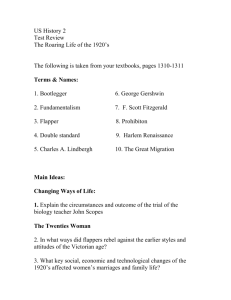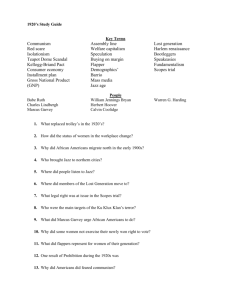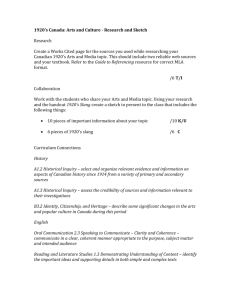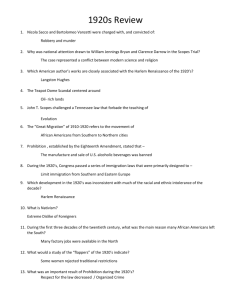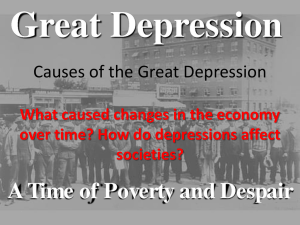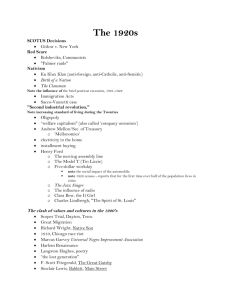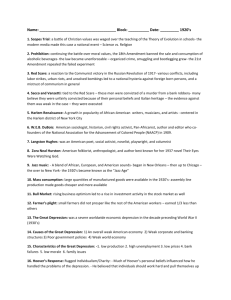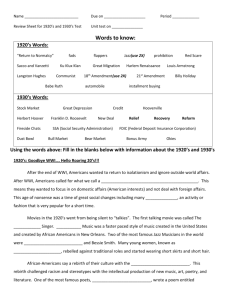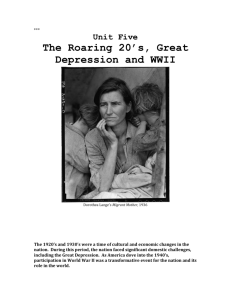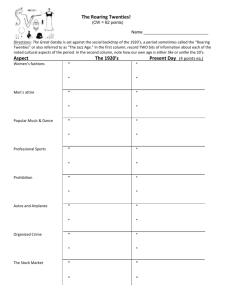Answer Key to the 1920s and 1930s packet
advertisement
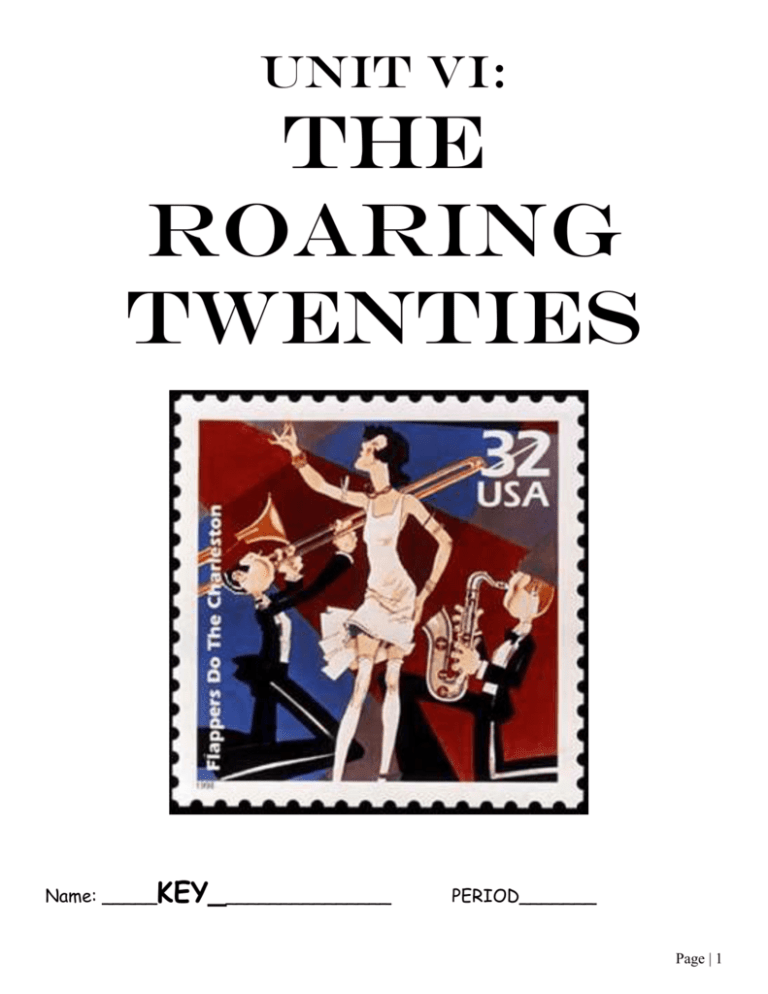
UNIT VI: The roaring twenties Name: _____KEY________________ PERIOD_______ Page | 1 1920’s VOCABULARY 1. Return (Back) to Normalcy - President Harding’s idea for the US to return to life as it had been before World War I. 2. Prohibition – 1920 – 1933 – alcohol was illegal 3. 18th amendment – banned the sale, manufacture, and transportation of alcohol 4. 21st amendment – ended prohibition 5. Anarchist - person against organized government 6. Communist – people who want government ownership of all property. 7. Red Scare - period during the 1920’s where people feared communism; communists and anarchists were arrested and foreigners were deported 8. Nativism - wanting to preserve America for native-born white Americans and limit immigration. 9. Quota Act – limited immigration. This law discriminated against people in Southern and Eastern Europe by limiting immigration from these countries more than Northern and Western Europe. 10. Harlem Renaissance - rebirth of African American culture in Harlem; African American musicians, artists, and writers settled in Harlem. 11. Installment buying - buying on credit. You could buy a product for a small down payment, take it home and then make monthly payments with interest. 12. Prosperity - state of growth, with rising profits and full employment. 13. Boom – a time of great economic activity and growth. 14. Bull market - when the stock market is doing well; the steady rise in stock prices. 15. Bear Market – when the stock market is NOT doing well; the steady decrease in stock prices. 16. Buying on margin (credit) - buy a stock for a 10% down payment from a broker. 17. Stock market crash - a sudden and steep drop in the price of stocks, eventually becoming worthless. Page | 2 Read the following introduction to the Roaring 20’s: The “Roaring Twenties” was a decade in which nothing big happened—there were no major catastrophes or large events—at least until the stock market crash of 1929—yet it is one of the most significant decades in U.S. history because of the great changes that came about in American society. The Twenties were known by various images and names: the Jazz Age, the age of the Lost Generation, flaming youth, flappers, radio and movies, bathtub gin, the speakeasy, organized crime, confession magazines, Hemingway and Fitzgerald, Charles Lindbergh, Babe Ruth, Bobby Jones, the Great Crash, Sacco and Vanzetti, Al Smith, cosmetics, Freud, the “new” woman, the Harlem Renaissance, consumerism—all these images and more are part of the fabulous Twenties! The 1920s provided something of a roller coaster ride for the American people. The euphoria surrounding the end of World War I was clouded by the great flu epidemic of 1919, the Red Scare of that year, and the frustration and bitterness left over from the fight over the ratification of the Treaty of Versailles. The progress made toward reform under progressive Presidents Roosevelt and Wilson slowed to a crawl, as many Americans began to feel the need for a break from the moral intensity of the Progressive Era. The 1920 election resulted in a Republican landslide. Harding/Coolidge received 16,152,200 popular votes and 404 electoral votes compared with Cox/Roosevelt totals of 9,147,353 popular votes and 127 electoral votes. Most memorable about the election of 1920 is that for the first time women had the right to vote. Though the Twenties was a decade of enormous social change, myths about the era sometimes exaggerate the reality of that strange and often troubling time. While consumerism boomed and many new inventions—radios and telephones, for example—became everyday items for many Americans, it was also a time of much bitterness, conflict, and disappointment. The economic boom left many in the dust, America’s traditional openness to immigration was severely cut back, and racial tensions rose. Prohibition, the “noble experiment,” caused ordinary citizens to resort to criminal behavior, even as government often winked and looked the other way. Following the Great War, as the only major Western nation not devastated by that conflict, Americans felt pretty good about themselves. The continued economic growth, political conservatism, and general absence of concerns over foreign affairs led Americans to think of themselves as “having it made.” Proof of America’s spirit and achievements seemed to be personified by Charles Lindbergh as he made his historic flight from New York to Paris in 1927. But the 1920s also saw deep divisions in the country despite the “roaring” atmosphere brought about by bathtub gin, speakeasies, flappers, women voting, jazz, sports, and all the rest. Then at the end of that self-satisfied, raucous, and somewhat grumpy decade, when the expectations of many Americans knew no bounds, the stock market crashed and the Great Depression hit. During the 1920s everybody seemed to be buying everything, and businesses set out to meet the demands of consumers, producing new products in record-breaking quantities. Cars, radios, appliances, ready-made clothes, gadgets, and other consumer products found their way into more and more American homes and garages. Americans also started buying stocks in greater numbers, providing capital to already booming companies. All the signs pointed upward, and starry-eyed men and women began to believe that it was going to be a one-way trip, possibly forever. Henry Ford’s assembly line not only revolutionized production, it democratized the ownership of the automobile. Ford showed that handsome profits could be made on small margin and high volume. By 1925 his famous Model T sold for less than $300, a modest price by the standards of the 1920s. Americans had never had it so good. (Many, of course, would not have it so good again for a long time The Twenties were also known as a time of revolution in manners and morals, when young men, and especially young women, threw off many of the social restrictions of the Victorian era and began conducting themselves in ways that scandalized the older generations. Young women liberated themselves in everything from hairstyles and clothing to deportment and public behavior, smoking cigarettes and drinking from flasks of illegal bootleg whiskey and bathtub gin. The ’20s were known as the jazz age and saw the rebirth of the Ku Klux Klan, divisions between town and country that went beyond mere style, the Harlem Renaissance, an enormous growth in production of items such as automobiles once seen as luxuries, and a general feeling of near euphoria, as if for the middle and wealthy classes, at least, things would just keep going up. Page | 3 The Twenties were in another sense a reactionary decade—a reaction against Victorian ideas of morality that saw young men and women openly defy what their parents still viewed as proper behavior for relationships between the sexes. Young people went wild, in the eyes of some, though studies have suggested that there was more talk than action. It was also a rebellious age, in which women continued the process of breaking out of older social patterns as they had begun to do during World War I. They changed their dress styles, cut their hair short, smoked in public, and were not above taking a nip from a flask of Prohibition whiskey. •PREDICT: Based on your reading and knowledge, what are some things you think we’ll be learning about in this unit? LIST AT LEAST THREE PREDICTIONS BELOW: Based on the Reading: Fill in how the following changed during the 1920’s. LIST as many examples as you can find from the reading… Automobile Women Appliances What’s installment buying? Page | 4 The Roaring Twenties: AKA The Jazz Age Politics and Prosperity in America (The Boom before the Bust) A return to isolationism after WWI 1920’S POWERPOINT Answer the questions and fill in the blanks while viewing the PowerPoint presentation during class. 1. What types of changes were brought about in the 1920’s? _Social_ __Economic____ __Political____ 2. What are SOCIAL changes? People’s __Lifestyles____ The way people __interact__ with one another Society as a ___whole___ 3. What is economic change? Changes in the production, ___distribution__, and ___consumption__ of goods and services 4. What is political change? Change in the __government____ The way people think about ____the government____ Change in ___laws___ Page | 5 Now let’s look at some of the SOCIAL changes that took place in the 1920’s MOVIES 5. How did movies change in the 1920’s? From silent movies to ___”Talkies”______ Let’s look at a clip of one of the silent films from that era Some famous silent movie stars include: Charlie Chaplin, Clara Row, and _Rudolph Valentine_ 6. What was the first “talkie”? The __Jazz__ Singer Pretty appropriate for the decade Let’s watch a little clip from this first talkie movie… Nothing like going to the movies today! Even Mickey Mouse started talking during this time period! He made his talking debut in __Steamboat Willie___ Let’s watch a clip from his first talking cartoon… MUSIC: The JAZZ AGE 7. What was the new kind of music and what was different about it? The __Jazz_ Age A faster paced style The first original music of the United States 8. Who founded this music? Started by _African-Americans___ in ___New Orleans__ 9. Who were two famous musicians of the time? Louis __Armstrong____ Bessie ___Smith____ Let’s listen to a couple clips from their songs Page | 6 DANCE 10. What was the new dance that kept pace with the new music? The ___Charleston______ A dance that kept pace with the __Jazz_ music Let’s watch a clip of the Charleston… WOMEN AND FASHION Define flapper: a young woman who rebelled against traditional fashion 11. What changed about women in the 1920’s? The Trend: the skirts and dresses grew __shorter__ and sleeker, along with their hair! Short hair, short skirts and wanted to dance Women were nicknamed ____flappers____: this signified the new independence of women 13. How did these young women offend the older generation? She offended the older generation because she defied conventions of ___acceptable feminine behavior____ (aka traditional behavior) 14. What aspects of flappers are shown in the drawing? List them all below… SHORT HAIR, SHORT BAGGY DRESSES SMOKING, WEARING MAKE-UP SHE IS EXPOSING HER ARMS AND LEGS Page | 7 HARLEM RENAISSANCE 15. What was the Harlem Renaissance? Rebirth of ___African American______ Culture o Through intellect and production of __music_______, art, and __literature___, African-Americans could challenge racism and ___stereotypes___ to promote racial and social integration. Watch the brainpop on the Harlem Renaissance 17. Who was a poet of the Harlem Renaissance? Poet __Langston__ Hughes One of his most famous poems was titled Dreams 18. What was the message of his poem Dreams? Dreams By Langston Hughs Hold fast to dreams For if dreams die Life is a broken-winged bird That cannot fly. Hold fast to dreams For when dreams go Life is a barren field Frozen with snow Message??? Keep dreaming of a better life because if you stop you lose all hope Page | 8 19. Who was an artist of the Harlem Renaissance? The artist Williams H. _Johnson___ Johnson painted thousands of pictures, many of which are now on display in the __Smithsonian____ in Washington DC 21. Who was a famous singer of the Harlem Renaissance? Singer __Billie_ Holiday Yes she was a girl…. Let’s listen to her sing one of her most famous songs: Strange Fruit STRANGE FRUIT Southern trees bear a strange fruit Blood on the leaves Blood at the root Black bodies swinging in the southern breeze Strange fruit hanging from the poplar trees Pastoral scene of the gallant South The bulging eyes and the twisted mouth The scent of magnolia sweet and fresh Then the sudden smell of burning flesh Here is a fruit for the crows to pluck For the rain to gather For the wind to suck For the sun to rot For the tree to drop Here is a strange and bitter crop Lyrics by: Lewis Anderson Originally sung by: Billie Holiday 22. What is she referring to as “strange fruit” in the song? The bodies of dead African-Americans in the south when they are lynched, killed by being hung from a tree Page | 9 THE GOLDEN AGE OF SPORTS 23. Who were some of the sports greats in the 1920’s and their sports? BASEBALL: ____Babe Ruth____, 60 home runs in 1927, played most of his career for the New York Yankees GOLF: ____Bobby Jones___, Started “The Masters”, competition that still exists today for golf TENNIS: ____Bill Tilden________ COLLEGE FOOTBALL: ___Red Grange___, the “galloping ghost”, ___Knute__ Rockne, SWIMMING: ___Gertrude Ederle_______, swims the English channel in 1927, RADIO 24. When was the first radio broadcast? The first radio station was KDKA Broadcast and it had its first broadcast on November 20, __1920__ 25. Why was the radio important? Radio provided for the whole ___family____ Entertainment, __sports___ and __news___ FADS: 1920’s The Wonderful Age of Nonsense Define fad: an activity or fashion that is very popular for a short time 26. What were some of the new fads of the 1920’s? Marathon Dancing: ___dance contests___, the last couple standing wins! These could usually last for __days__! Flagpole __sitting___: Record: Shipwreck Kelly, __1924__, sat for almost 13 hours!! Page | 10 Literature Famous authors from this time period include: Ernest __Hemingway__: A passionate young author who used history and experience to write his books, including A Farwell to Arms (about WWI), The Old Man and the Sea F.Scott __Fitzgerald___: A young author who best captured the mood of the Roaring Twenties, including The Great Gatsby, The Curious Case of Benjamin Button POLITICAL CHANGES IN THE 1920’S WOMEN’S RIGHTS Protests: In front of the White House (remember this from out Progressive Era) Alice Paul: led protests outside the White House, arrested for ______civil disobedience ______, increased peoples __awareness_ of women’s rights 27. What was the 19th Amendment? “The right of the citizens of the United States to vote shall not be denied or abridged by the United States or by any state on the account of _sex__” Women are now guaranteed the RIGHT TO VOTE!!! PROHIBITION 28. What was the 18th Amendment? “The manufacture, _sale__, or ___transportation___ of intoxicating liquors within the United States…is hereby prohibited” Closing the saloons: Usually __FBI_ agents Page | 11 Why not the local police? Because __gangsters_ would pay off ___policemen___, public officials, and judges to look the other way. This is why the FBI had to step in. They are a national police enforcement group out of Washington D.C. 29. What kind of illegal activities occurred during Prohibition at speakeasies? Raids on Speakeasies: Served illegal ____alcohol___ and provided illegal ____gambling____ Define Speakeasy: nickname for the illegal bars of the 1920’s Define Bootlegging: the people who were smuggling alcohol, nickname came about because the early smugglers hid alcohol in boots Organized Crime: __Al Capone___: Most famous gangster of the 1920’s, became rich and powerful from ____prohibition___ Was sent to jail for tax evasion because the FBI couldn’t catch him with his other illegal activities 30. What was the 21st Amendment? Signed into law in 1933 The eighteenth article of amendment to the Constitution of the United States is hereby ___repealed__” This means we got rid of the prohibition law, alcohol is now legal Anti-Foreign Sentiment 31. What was the Red Scare? Fear that ___Communists___ would take over the United States Immigration: The Immigration ___Quota Act__ was passed into law in 1921 This law __limited__ new immigrants to 3% of the nationality already in the United States 32. How did the Red Scare affect the Sacco and Vanzetti trial? Two Italian immigrants accused and convicted of ____murder____ and sentenced to death. They both swear they did not commit a crime. Many believed their conviction was the result of ___anti-foreign/ nativists_____ sentiment during the 1920’s Page | 12 Problem was the men were convicted with very little evidence. This court case led to a rise in ____nativism___ (a distrust of foreigners) The re-emergence of The Ku Klux Klan 33. Who was the KKK against? The Klan in the 1920’s: membership grew to an estimated __4-5 million___ Now this group _____discriminated_____ not only against AfricanAmericans but added ____Catholics_____ and ___Jews__ to its hate list Tactics: Used ___terror___ and violence, lynching, and __burning__ crosses as a warning Economic Change In the 1920’s Advertising 34. How did advertising change in the 1920’s? Old and new: magazines, ___newspapers___, billboards, and advertising on the radio, advertising before __movies___ Today’s advertising was born in the 1920’s. New tactics, including ___scaring____ people!! Automobile 35. How did the automobile affect society in the 1920’s? Model T built by the __Ford__ motor company 1909-1927 Affordable to the average American Cars produced: 1920: _____2 million___, 1929: ____5.5 million___ By late 1900’s: One car for every __five____ Americans Promoted other industries like ____oil__, steel, and ___rubber___ Created new service _____facilities______ ____highways_ had to be built Now we need to build gas _____stations____ for cars to refuel Page | 13 36. What is installment buying or buying “on credit”? When you buy on credit you put down one ___payment___, and then pay the rest __monthly____ until the loan is paid off Home owners wanted all of the new ___inventions____ and appliances that were available. If they didn’t have the cash for it, they could buy it using credit and pay it off later, with __interest__ New purchases included: the automobile, electric __iron_, toaster, vacuum, ___stove_, radios, and _washing___ machines Stock Market Crash October 1929 The End of the 1920’s 37. What caused the stock market to crash? The stock market crashed when there was a sudden and steep drop in the price of _stocks__. Stockbrokers were calling in their __loans__ so people were trying to make money. This caused the price of stocks to ____decrease____ steadily and eventually become worthless. Page | 14 Blue Skies Written by Irving Berlin (1926) I was blue, just as blue as I could be Ev'ry day was a cloudy day for me Then good luck came a-knocking at my door Skies were gray but they're not gray anymore Blue skies Smiling at me Nothing but blue skies Do I see Bluebirds Singing a song Nothing but bluebirds All day long Never saw the sun shining so bright Never saw things going so right Noticing the days hurrying by When you're in love, my how they fly Blue days All of them gone Nothing but blue skies From now on During the 1920’s radio and movies were popular forms of entertainment. Up until this point in history, movies had been silent, the technology for adding sound did not exist. A “talkie” was the nickname given to the first movies that had sound. This song was one of the songs that appeared in the first full length "talkie," "The Jazz Singer" in 1927. It is also one of the most popular songs of the 1920’s and has been remade by many artists over the years. Verse [2] I should care if the wind blows east or west I should fret if the worst looks like the best I should mind if they say it can't be true I should smile, that's exactly what I do 1. How do these lyrics and the mood of the music relate to what you have learned about life in the 1920’s? Give me at least 3 specific examples: Page | 15 Some 1920’s fun facts: 1920s candy 1920 - Baby Ruth were made and named after President Grover Cleveland's daughter instead of the baseball player. 1922 - Mounds candy bar were first made 1923 - Milky Ways were invented and designed to taste like Malted Milk, made by the Mars family. 1923 - Reeses cups are made, which are now still known as one of the top selling candies. 1924 - Bit-o-honey were made for the first time 1925 - Mr. Goodbar were created and are known for the combination of creamy milk chocolate and crunchy peanuts 1926 - Milk Duds were formulated, the original idea for the milk duds were for them to be perfectly round, finding that wouldn’t work, the word "dud" was used. 1927 - Raisinets were invented 1928 - Heath Bars were made for the first time 1929 - Twizzlers company is established and creates the gummy Late 1920s - Butterfingers were made, and were the second top selling candy at that time. They were made by the same company that made Baby Ruth bars. 1930 - Snickers were designed and were named after the family’s horse. Lifesavers – 1912 named after the floatation device, created as a summer candy alternative to chocolate which would melt. The 5 flavor roll came out in 1935 Jazz Age Glossary: The 1920’s were an extraordinary few years for language in America. Dozens of new words and expressions were created for this roaring decade. Many will sound familiar to you today! Belly laugh: a loud, uninhibited laugh Big cheese: an important person Bunk: nonsense Cat’s meow: anything wonderful Cheaters: nickname for eyeglasses Crush: an infatuation or liking of another person Fall guy: someone who takes the blame even when they haven’t done anything Flapper: young girl in the 1920’s Gatecrasher: a person who attends a party and wasn’t invited Jalopy: old car Kiddo: a familiar form of addressing someone you know Pushover: a person or thing easily overcome Scram: telling someone to leave or go away Swell: when something is nice or marvelous Page | 16 UNIT VII: The great depression KEY__________ Name: _______ PERIOD________ Page | 17 1930’s VOCABULARY 1. Bull Market - continuing rise in stock prices 2. Buying on Margin - buying stocks on credit with a loan from a broker 3. Speculation - buying stocks in the hope of making a profit. 4. Stock Market Crash - October 29, 1929 the stock market completely collapsed; stocks became worthless 5. Bear Market - continuing drop in stock prices 6. Great Depression - a time of high unemployment and low productivity. 7. Hoovervilles - shacks where the homeless lived. Many people blamed President Hoover for not doing enough to help America get out of the Great Depression so the shacks were named after him. 8. Dust Bowl – severe drought hit the Great Plains destroying millions of acres of farm land. 9. Okies - migrant farm workers from Oklahoma who moved west during the Dust Bowl. 10. Fireside chats - FDR gave speeches over the radio sitting by his fireplace; families gathered around their radios because they felt that FDR understood their problems 11. New Deal - FDR’s plan for getting America out of the Great Depression; He started hundreds of programs - relief for the unemployed, plans to recover the economy from a depression, and reforms to prevent another depression Page | 18 1930’s and the Great Depression POWERPOINT PRESENTATION For most of the 1920’s there was a ___Bull Market__. A ____Bull___ is when the stock market was doing well and stock prices were ___rising___. TWO Problems with the stock market: Buying stocks on ____margin____- buying stocks using ___credit__, not cash Speculation- buying stocks in the hope of making a _____profit___ From 1929-1932 there was a ____Bear Market______- A ___Bear_ market is when the stock market was NOT doing well and stock prices __fall/decrease___ Stock Market Crash Everyone tried to __sell___ their stocks and the stocks became ______worthless_________. When the stock market crashed, people went to the banks to get their money, but it was ____gone__! Watch Brainpop on Causes of the Great Depression Page | 19 What were the causes of the Great Depression? Installment Buying and buying __stocks__ on ____margin____ The overproduction of goods and ___crops_. Factories and ___farms___ were producing too much causing prices to go down United States made large __loans_ to __Europe_, but we had to stop giving loans, which caused Europe’s banks to __close_. The same cycle occurred overseas causing a ______worldwide depression_____ T H E G R E A T D E P R E S S I O N Banks _loaned_ money without any to back it up, so when people went to get their ___money_______ out of the bank it was __gone_ Cycle of ____disaster____businesses can’t get loans from __banks___, so businesses cut wages, hours, and laid off workers don’t have money to buy goods, so businesses went _____bankrupt___ Page | 20 The Dust Bowl How were the black blizzards of the Dust Bowl formed? Severe drought hit the ____Great Plains__ from 1931-1939. The black blizzards formed from the ___dry soil__ and 50 mph winds. They destroyed over _______5 million____ acres of land. It ended when ___rain_ finally fell consistently and temperatures remained steady. During the Dust Bowl, temperatures changed 70 degrees in a matter of hours. In addition there were record highs of 120 degrees and no rain for months. The Dust Bowl forced hundreds of ___farmers___ and their families to move __west_ to _____California______ to start a new life Who were Okies? A family from Oklahoma packed up all their belongings and headed for ____California_____ where they hoped to find better soil and start a new life. These ___migrant____ families were nicknamed _____Okies____ Page | 21 President Herbert Hoover 31st President 1928-1932 What did President Hoover believe about the economy? Herbert Hoover believed in laissez-fair government. He started some programs to help the United States get out of the ____Great Depression_______ but they did not apply to the masses of people who were ____unemployed_____ Most people did not believe Hoover was doing enough, so the shacks that the ___poor__ people lived in were called ___Hoovervilles___ and the _______newspapers______ that people covered up with were called Hoover blankets Page | 22 Watch Brainpop: The Great Depression What was the bonus army? How did President Hoover respond? World War I ___veterans___ nicknamed the “___Bonus Army___” asking for President Hoover to give them their army bonuses early. Veterans of this war were promised a bonus not to be given until 1945. Because of the Great Depression, over 60,000 veterans marched on _____Washington ____D.C.____ asking for it to be given early. President Hoover ___rejected___ their request, but paid for their railway tickets back home instead. Franklin Delano Roosevelt 32nd President 1932-1945 Why did FDR win a landslide victory? People were fed up with the lack of results from __Hoover’s___ programs and Franklin Delano Roosevelt won a landslide victory in __1932__. People were happy to see Roosevelt’s new programs started in his first ___term__ in office. However not everyone was happy. Many _____republicans______ criticized FDR’s approach to taking over ____businesses____. This seemed too close to communism for some people. ____Congress___ didn’t pass several of FDR’s programs, but hundreds of others were still passed. Page | 23 Watch Brainpop on FDR What were fireside chats? Fireside Chats – President Roosevelt spoke to the American public over the ____radio____. “Tonight, (May 7, ___1933___) I come to you for the second time to give you my report -- to tell you about what we are doing and what we _____plan___ to do.” Here are some examples of what FDR told people to make them feel better about their situation: • Congress is about to pass legislation that will help ___homeowners___ and ____farmers___ pay their mortgage (money they owe on their homes) • A grant of half a __billion_____ dollars is to be given to care for those who need direct and immediate relief. • Congress authorized the sale of ___beer__ in such states as desired. This has already resulted in _____job growth_____ and has provided much needed ___tax__ revenue. Page | 24 What was the New Deal? (Definition) FDR’s plan for getting the United States out of the ___Great Depression___ Some of the New Deal Programs Name of New Deal program SSA – Social Security Act *Still exists today* Describe the program Provided ____unemployment___ benefits, ____insurance and ______ pensions and aid to the elderly and to the disabled TVA – Tennessee Valley Authority Federal government built a series of _dams__ to prevent flooding, brought _water_ supply and ___electricity____ to rural areas- provided jobs for people who helped with construction CCC – Civilian Conservation Corporation Sent 250,000 young men to work camps to perform reforestation and ___conservation___ tasks. Removed surplus of workers from __cities__, provided healthy conditions for boys, and provided ___money_____ for families AAA – Agricultural Adjustment Agency Protected farmers from price _drops__ by reducing production, and starting ____educational__ programs to teach methods of preventing ___soil___ erosion Page | 25 FDIC – Federal Deposit Insurance Corporation Created federally insured bank ___deposits__ ($__2500__ per investor at first) to prevent bank *Still exists today* ____failures___. Now protects up to PWA – Public Works Administration States received $3.3 billion $___100,000___ per investor. appropriation from __Congress__ for Define Public Works: Projects built by the government for public use like parks, schools, highways, roads, government buildings, public works projects. SEC – Securities and Exchange Commission Regulated the __stock__ market and Provided ___jobs__ to needy areas through public projects restricted ____margin_ buying *Still exists today* Distributed millions of dollars of direct FERA – Federal Emergency Relief Act aid to unemployed workers, including food, ___clothing_, shelter, and ___job___ training. • For example teaching woman to sew and providing sewing machines to make clothes for their families Also, creating a community garden projects where people work planting food and take home what they have produced Page | 26 Watch Brainpop: Watch the New Deal FDR’s New Deal programs helped ___relieve__ people jobs, food, and shelter. It some problems by giving ___reformed____ some problems, such as the banking system (FDIC) and pay for the elderly and handicapped (SSA). However it did not completely ____recover____ America’s economy from the Great Depression before the start of World War II. Recovery from a depression takes a long time and the start of ____WWII__ will make this happen faster than the New Deal could have. What programs still exist today? The _____SEC___, ____SSA____, and ___FDIC_ were so important that they still exist today Explain some of the criticisms of the New Deal: • Gave the ___federal___ government too much power • Cost too much _____money______ Was there good reason for these criticisms? Why or why not? What pulled the United States out of the Great Depression so quickly? Producing goods (such as weapons, __airplanes___, tanks, ___weapons___, and other supplies for the _____army_______) for WWII is what pulled the US out of the Great Depression. We had to mobilize all of our factories to help in the war effort producing new jobs all over the country. Page | 27 Heroes and Entertainment of the 1930’s Popular movies of the 1930’s: Gone with the ___Wind__- about the Civil War Snow White and the 7 ___Dwarfs__- Disney classic Wizard of Oz- this is the story about Dorothy and her magical trip to OZ ____King Kong__- story of a giant ape that is captured from mysterious skull island then brought back to the mainland Radio Programs: War of the ___Worlds___, created by Orson Wells FDR’s ___Fireside__ chats- done weekly from the White House to help inform the public of what the government was doing to fix the Great Depression Legends and heroes of the 1930’s: Jesse __Owens_- Olympic star of the 1936 games, won FOUR gold medals in track and field events in Berlin, Germany Joe ___DiMaggio__- Baseball star on the New York Yankees, record Amelia ___Earhart_- famous female pilot, went missing on her solo flight around the world in 1937 New Board Games: Monopoly Page | 28 Name __________________________________________________ Complete the chart using your NOTES – Tear off this page and hand in for homework SUM UP THE GREAT DEPRESSION CAUSES OF THE GREAT DEPRESSION: 1.) EFFECTS ON THE AMERICAN PEOPLE: List at least 4 2.) 3.) 4.) FDR CREATES THE _______ _______. WHICH DOES WHAT? PROGRAMS MEANT TO HELP PEOPLE: (LIST ALL IN NOTES) THE U.S. FINALLY GETS OUT OF THE GREAT DEPRESSION, BUT COMPLETELY BECAUSE OF FDR’S _________ ________, BUT BECAUSE OF ________. Page | 29
